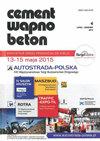An evaluation of cooling Portland cement mortars exposed to high temperature, by using firefighting foam
IF 0.6
4区 工程技术
Q4 CONSTRUCTION & BUILDING TECHNOLOGY
引用次数: 0
Abstract
The purpose of this study was to investigate the effects of cooling Portland cement mortars exposed to high temperature, with synthetic high-expansion firefighting foam. In this experimental study, mortar samples produced with Portland cement CEM I 42,5R, Rilem-Cembureau sand and tap water were first subjected to water curing for 28, 90 and 180 days and then exposed to 20°C, 150°C, 300°C, 500°C and 700°C for 3 hours, respectively. Cement mortars exposed to high temperatures were cooled with high expansion firefighting foam and the resulting flexural strength and compressive strengths were evaluated according to hydration period and temperature parameters. Subsequently, 180-day cement mortar samples exposed to high temperature were cooled using air, water, and foam cooling methods. It was determined that the air cooling method resulted in a higher compressive strength than water or foam cooling. The flexural strength, compressive strength, ultrasonic pulse velocity, and mass loss percentage values, obtained by the different cooling methods and exposure temperatures employed, were then analysed. It was determined that samples exposed to 500°C, cooling with firefighting foam, yielded a compressive strength of 9% higher, compared to water cooling. SEM images of 180-day Portland cement mortars exposed to 20°C, 300°C and 700°C and subsequently air, water and foam cooled, respectively, were obtained and analysed.消防泡沫对高温下硅酸盐水泥砂浆冷却性能的评价
本研究的目的是研究在高温下使用合成高膨胀消防泡沫冷却波特兰水泥砂浆的效果。在本实验研究中,采用波特兰水泥CEM I 42、5R、Rilem-Cembureau砂和自来水制作砂浆样品,首先进行28、90和180天的水养护,然后分别在20°C、150°C、300°C、500°C和700°C条件下养护3小时。采用高膨胀消防泡沫冷却高温水泥砂浆,并根据水化时间和温度参数评价其抗折强度和抗压强度。随后,使用空气、水和泡沫冷却方法对高温下180天的水泥砂浆样品进行冷却。结果表明,空气冷却比水冷却或泡沫冷却具有更高的抗压强度。然后分析了不同冷却方法和暴露温度所获得的抗弯强度、抗压强度、超声波脉冲速度和质量损失率值。经测定,与水冷却相比,暴露在500°C下,用消防泡沫冷却的样品产生的抗压强度高出9%。获得并分析了180天波特兰水泥砂浆分别暴露于20°C、300°C和700°C以及随后的空气、水和泡沫冷却的SEM图像。
本文章由计算机程序翻译,如有差异,请以英文原文为准。
求助全文
约1分钟内获得全文
求助全文
来源期刊

Cement Wapno Beton
CONSTRUCTION & BUILDING TECHNOLOGY-MATERIALS SCIENCE, COMPOSITES
CiteScore
1.30
自引率
28.60%
发文量
0
审稿时长
>12 weeks
期刊介绍:
The Publisher of the scientific bimonthly of international circulation, entitled "Cement-Wapno-Beton" ["Cement-Lime-Concrete"], is the Fundacja Cement, Wapno, Beton [Foundation Cement, Lime, Concrete]. The periodical is dedicated to the issues concerning mineral setting materials and concrete. It is concerned with the publication of academic and research works from the field of chemistry and technology of building setting materials and concrete
 求助内容:
求助内容: 应助结果提醒方式:
应助结果提醒方式:


